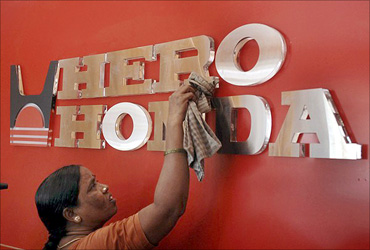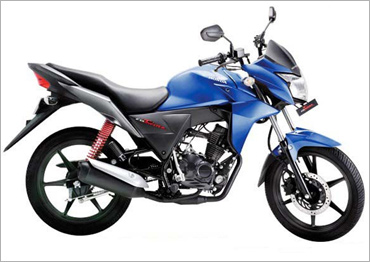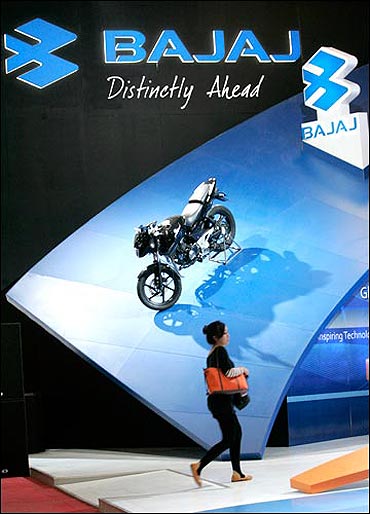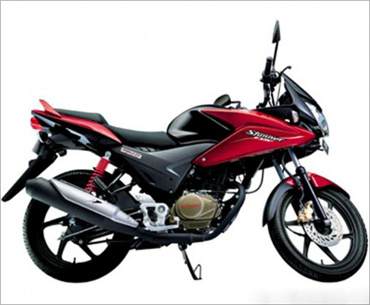 | « Back to article | Print this article |
Difficult road ahead for Honda
When the Hero Group terminated its 26-year-old joint venture, Hero Honda, with the Japanese auto major Honda Motor Corporation in December last year, the decision did not spring a major surprise.
Reports of friction between the JV partners had been doing the rounds since HMC decided to enter the Indian market through its wholly-owned subsidiary Honda Motorcycle and Scooter India in 1999.
Post the split, the two companies are free to follow their desired growth path. So while the Hero Group is working out a new brand strategy, HMSI is preparing to step on the gas and corner a larger share in what is ranked as the second largest two-wheeler market in the world.
But that, to use a clich , is easier said than done. Scooters currently are the mainstay for HMSI - it is the No. 1 player in the segment in the domestic market with 43.2 per cent share - and to compete effectively in the two-wheeler market in India, the company needs to make an imprint in motorcycles, a segment where it is No. 4 with a share of 7.4 per cent. (Society of Indian Automobile Manufacturers data for April-January)
The Honda management knows how the odds stack up.
Shinji Aoyama, president and chief executive officer, HMSI, said: "Whatever we did not have in our product portfolio we are in a hurry to fill up. Introducing inexpensive models is a crucial area for us. While we will not disturb existing Hero Honda customers, we will concentrate extensively in beefing up our line-up in the country."
Instant history
There are compelling historical reasons for its earlier lack of enthusiasm for the motorcycle segment.
Its joint venture agreement with Hero Honda precluded it from entering the motorcycle market for the first five years with the result that HMSI now accounts for just about 6 per cent of the parent company's two-wheeler revenues globally.
As things stand, HMSI is the fourth largest two-wheeler manufacturer in India today with a market share of around 14 per cent after Hero Honda, Bajaj Auto and TVS Motors, with the top two - Hero Honda and Bajaj Auto - together accounting for over 70 per cent of the market.
Click NEXT to read further...
Difficult road ahead for Honda
Its motorcycle portfolio includes the CB Twister (Honda's sole offering in the best-selling 110 cc segment), the CB Shine, the CB Stunner and the CB Stunner PGM-Fi in the 125 cc segment and the CB Unicorn and CB Dazzler in the 150 cc category.
The challenge is not just about securing a stronger foothold in motorcycles - it's also about getting the product mix right.
The problem is simple: the low-frills commuter segment (100-150 cc displacement) constitutes the bulk of the motorcycle sales in the country - this is the segment which has made Hero Honda the world's largest-selling motorcycle company - and HMSI did not have any product in the segment till last April when it launched the 110 cc CB Twister.
Industry experts note that nearly 60 per cent of the nine million motorcycles sold last fiscal came from products in the 100-110 cc segment and Hero Honda Splendor alone sold two million units in the segment.
VG Ramakrishnan, senior director, Frost & Sullivan, said: "The pressure would increase on the Indian subsidiary to increase sales in the motorcycle segment.
"While it would not be difficult for HMSI to get products into the Indian market, to scale up volumes it will have to get the pricing right."
The HMSI management is unruffled. "We are the fastest-growing two-wheeler company in India," said Aoyama.
"We expect to sell 1.6 million units this fiscal, within 10 years of starting our operations in India. It took Hero Honda 18 years to touch that milestone."
In January this year, the company acquired seven million customers, with the last million achieved in a record time of seven months.
Last fiscal HMSI sold 1.27 million units, which is an increase of over 18 per cent as compared to the 1.07 million units sold during 2008-09.
Hero Honda, in the meantime, grew by 23.6 per cent last fiscal to sell 4.6 million units - the volume registered by it was nearly four times that of HMSI.
Aoyama concedes it is crucial to introduce mass market products to drive up volumes in the Indian market.
Click NEXT to read further...
Difficult road ahead for Honda
Going ahead, HMSI is looking at launching "inexpensive models" in the 100+ cc and 150 cc segments to grab a bigger share of the market.
Naresh Rattan, head of operations (sales & marketing), HMSI, said: "Over the short term, the termination of the JV with Hero Honda would not drive our plans. But on a long-term basis, an independent world leader like Honda will think more progressively. The product portfolio will change dramatically."
Roadblocks ahead
But the core products, Aoyama talks of, would take a couple of years to hit Indian roads. "We have huge backlogs because of constraints in supply," said Aoyama.
"Even the 1.6 million units we expect to sell this year do not reflect the actual demand for our products in the market. Our dealers are not being able to cash in on many potential sales. As per our dealers' projections, we could have sold another 1 million units if we were able to meet the demand in the market," said Aoyama.
Company executives believe HMSI's Activa scooter alone has the potential to sell around a million units annually compared to the current 0.70 million units if production constraints can be overcome.
Similarly, volumes can double for the CB Shine (125 cc) and the CB Unicorn (150 cc), which are finding increasing appeal among consumers.
To take care of this issue, the company has invested Rs 500 crore to set up a second facility at Tapukara in Rajasthan.
When the plant becomes operational in September-October 2011, the combined capacity at the two manufacturing units - the other being at Manesar (Haryana) - would increase by around 37 per cent to 2.2 million units per annum.
HMSI's Manesar facility has the capacity to roll out 1.6 million units on an annual basis.
The additional capacity, the company admits, would not be sufficient to fully bridge the gap between demand and supply. HMSI products, at present, have a waiting period ranging from six weeks to six months.
The company takes, for instance, around seven months to deliver a Honda Activa in south India. HMSI is considering a third facility, likely to be set up in the southern or the western part of the country, to speed up delivery of products.
Aoyama said: "Tamil Nadu, Andhra Pradesh, Kerala and Karnataka account for 30 per cent of the overall demand for two-wheelers in India. Together, south and west India represent half of our business. It does not make any sense for us to limit our presence to north India when the business is spreading across the country. It is a natural decision to move south to ensure speedy delivery."
Click NEXT to read further...
Difficult road ahead for Honda
Industry insiders also raise concerns over Honda's ability to put in place a distribution network that can take on the might of Hero Honda and Bajaj Auto, which have 4,500 and 3,600 touch points respectively.
Rakesh Batra, analyst, automotive practice, Ernst &Young, said: "Hero Honda has cultivated marketing initiatives at the grassroots level over the last 30 years. To grow volumes, HMSI would have to reach out to customers in rural areas. The company also needs to put in place a cost-effective supply chain for delivering products."
HMSI has a distribution network of 800 dealers and sub-dealers. The company plans to add on 100 outlets in the current fiscal and an average of 200 new sales stations every year.
Rattan said: "It is easy to set up a dealer network but difficult to ensure quality services. Each of our business partners is the controller of marketing activities in his own place. We have dedicated people with specific skills and they are not mere investors. Ours is a smaller but a successful model. We average sales of 2,000 units every year from each outlet."
Also to be addressed appropriately are issues related to strained industrial relations which have plagued HMSI. Soon after the announcement of the split with the Hero Group, production came to a halt at the Manesar factory on December 17 last year when workers protested an alleged assault on a casual worker by a security staff.
In 2009, HMSI had suffered losses of over Rs, 300 crore (Rs. 3 billion) after workers went on a go-slow strike that had resulted in production dipping by over 50 per cent for nearly three months.
The biggest crisis was witnessed in 2005 when a violent strike by workers had rocked the Gurgaon-Manesar belt. "Labour problems is an open issue at HMSI and in the company's own interest, the matter has to be set right as soon as possible," adds an industry expert.
Above all, experts said, HMSI needs to work on re-establishing the uniqueness of the Honda brand in the country so that consumer loyalty to HMSI does not get transferred to Hero Honda.
Fast forward
HMSI knows it has its task cut out and has started addressing all these issues. "Earlier Honda was divided on what to offer Hero Honda and what to keep in its portfolio," said Rattan.
"The horizon will open up now; some core products will be developed for India. When CB Shine was introduced there was no 125 cc market. Over the years Shine has become a self-styled core product."
More offerings would eventually come up in the 110 cc and 150 cc segment both of which are showing healthy growth numbers.
Click NEXT to read further...
Difficult road ahead for Honda
People in semi-urban and rural areas today, said Rattan, are aspiring for products originally targeted at youngsters in urban markets.
HMSI may also consider a step-through for the Indian market.
Aoyama said: "We have products in Europe and Vietnam with flat floors and larger 16-inch wheels that are better suited for Indian road conditions. The concept can be tried out in India, though but we do not have any specific plans at the moment."
The $600 (Rs. 27,000) bike that is being developed by HMC in China is, however, unlikely to find its way to the Indian market.
Aoyama said: "The model is not suited to market requirements here and is being built largely for sale in Africa. The requirements in the African market are very basic which is not so in India. Till recently even headlights without visors were not accepted in the market here."
HMSI has also firmed up plans to launch the 250cc CBR250R in April this year. Following this, two/three models, including possible upgrades, will be introduced every year in the country. Also on the cards is an automatic scooter which would be introduced in 2011-12.
In fact, it has no plans to take its eyes off the scooter market.
Aoyama said: "People used to believe the running cost of scooters is more than that of motorcycles. The conception has changed - the current mileage of scooters is comparable to that of motorcycles. The weight of automatic scooters has increased from 12 per cent to 25 per cent in the overall two-wheeler market over the last four years. Weight of automatic scooters will now become bigger in overall two wheeler sales in the country. We will continue to actively focus on the segment."
Last year, the company sold 7.5 lakh scooters and 5.2 lakh motorcycles, which it hopes would increase to 8.6 lakh units and 7.4 lakh units respectively this fiscal in tandem with category growth.
According to data available from SIAM, 1.9 million scooters have been sold in the country in the first 11 months of the current fiscal which is an increase of 46.58 per cent as compared to the corresponding period last year. Motorcycle sales in the period have risen by 23.57 per cent to 7.4 million units.
The goal is clear for Aoyama.
"Honda is the number one two-wheeler brand worldwide and we want to be the number one player in India as well," he said.






